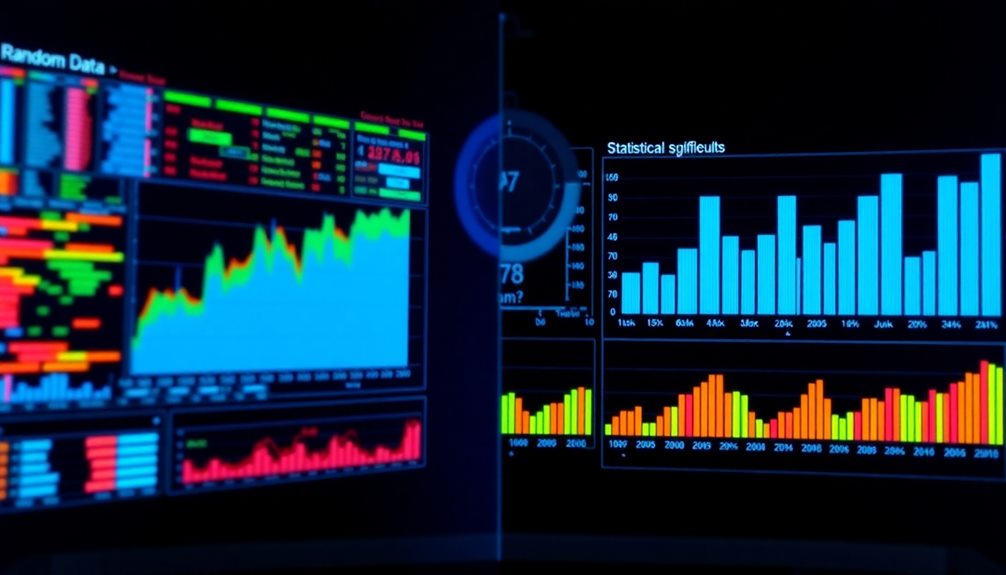AI-powered split testing transforms your marketing approach by making it easier to duplicate successful strategies. By automating data analysis, you can quickly identify winning variations and optimize your campaigns in real time. Techniques like multi-armed bandit algorithms guarantee that traffic is allocated to the best-performing elements, while personalized content can greatly enhance engagement and conversion rates. Statistical analysis confirms the effectiveness of your changes, assuring you're making informed decisions. As you explore further, you'll uncover additional insights that can elevate your marketing efforts even more.
Key Takeaways
- AI streamlines A/B testing by automating data analysis and providing rapid insights for immediate campaign adjustments.
- Utilizing Multi-Armed Bandit algorithms optimizes traffic allocation to high-performing variations, enhancing overall testing efficiency.
- Personalized content delivery through AI-driven segmentation increases engagement, click-through rates, and conversion rates significantly.
- Continuous improvement with AI harnesses historical data to replicate successful tactics, improving ROI across marketing campaigns.
- Real-time data processing allows for swift adjustments to testing strategies, boosting user retention and overall campaign effectiveness.
Understanding AI-Powered Split Testing

Understanding AI-powered split testing brings clarity to a complex process. You're diving into A/B testing, where AI streamlines your ability to analyze large datasets quickly. Instead of manually sifting through data, AI algorithms automate the identification of statistically notable results, letting you confidently replicate successful strategies while reducing reliance on inconclusive data.
By leveraging AI to create AI content clusters, you can enhance the relevance and authority of your campaigns, driving even better results.
With real-time data analysis, you can make immediate adjustments to campaigns. This optimization often involves using techniques like Multi-Armed Bandit algorithms, which allocate traffic to high-performing variations effortlessly.
As you segment your audience based on behavior and preferences, personalization becomes a powerful tool. Tailored messaging can notably boost engagement and conversion rates, ensuring you connect with your audience effectively.
Moreover, AI continuously learns from your insights, adapting your marketing strategies to evolving audience preferences. This adaptability enables you to duplicate winning strategies over time, enhancing your overall effectiveness.
Benefits of AI in Marketing

The integration of AI into marketing brings a transformative advantage, enhancing both efficiency and effectiveness. With AI-driven A/B testing, you can automate processes that analyze large datasets quickly, pinpointing winning strategies with remarkable accuracy. This allows you to optimize email marketing campaigns effectively, leading to considerably higher engagement rates.
Here's how AI enhances your marketing efforts:
| Benefit | Description | Impact |
|---|---|---|
| Personalized Content Delivery | Tailors content based on user behavior | Up to 450% higher click-through rates |
| Predictive Analytics | Anticipates user behavior trends | Proactive marketing strategies |
| Data-Driven Insights | Provides real-time data processing | Improved ROI, revenue increases of over 120% |
Crafting Effective Content Variations

When crafting effective content variations, you can quickly generate multiple alternatives that resonate with your target audience.
Incorporating diversifying investments into your strategy can enhance your ability to test different elements, allowing you to see what truly captures attention.
By using rapid iteration techniques, you can test different elements to see what truly captures attention.
This approach not only enhances engagement but also helps you refine your messaging for peak performance.
Generating Content Alternatives
Frequently, marketers find themselves needing to create multiple content variations to engage different audience segments effectively. With AI for A/B testing, you can quickly generate diverse headlines, body text, and calls to action. This rapid iteration not only saves time but also improves your optimization efforts.
For instance, effective air purifier maintenance can be likened to continually refining your content strategy based on performance data.
By leveraging user behavior data, AI identifies which content variations resonate best, leading to increased engagement rates. Brands using AI-generated content alternatives have reported up to a 450% increase in click-through rates, showcasing the power of tailored messaging.
Personalization plays an essential role here; when your content aligns with user preferences, it greatly boosts customer satisfaction and loyalty.
Moreover, AI's ability to analyze real-time performance data allows you to refine your messaging continuously. As you test and learn, you can adapt your strategies to meet your audience's evolving needs.
This ongoing optimization guarantees that your marketing efforts are always aligned with what works best, maximizing your impact. Embracing AI for generating content alternatives not only streamlines your process but also enhances the effectiveness of your campaigns, leading to sustained success in the competitive landscape.
Target Audience Resonance
Crafting effective content variations hinges on understanding your target audience's preferences and behaviors. By leveraging AI tools, you can analyze user data to generate personalized content variations that resonate with your audience. This not only boosts engagement but also helps you optimize your marketing efforts.
Consider these key strategies:
- Utilize A/B testing platforms to compare different content variations and determine which ones engage your audience best.
- Analyze past interactions to identify trends and preferences that can inform your content creation.
- Create personalized content variations that speak directly to different audience segments, enhancing relevance and appeal.
- Gather actionable insights from AI analyses to refine your content continuously, ensuring it remains effective over time.
Rapid Iteration Techniques
Utilizing AI-driven tools can greatly streamline your content creation process, allowing for rapid iteration of effective content variations. With these tools, you can quickly generate multiple ad copies or landing page designs, enabling rapid testing that optimizes your campaigns without starting from scratch.
AI learns from user engagement data, helping you identify which content variations resonate most with your target audience.
By implementing AI for rapid iteration, you can considerably increase the volume of A/B tests you conduct, enhancing the speed and efficiency of your testing process. This means you're not just analyzing data from past campaigns; you're continuously adapting your strategies in real-time.
AI automates the generation of diverse content styles, allowing you to experiment with different tones, structures, and messaging strategies.
As you test different variations, AI insights guide your decisions, ensuring your content remains relevant and effective. By embracing these rapid iteration techniques, you're not only crafting compelling content but also paving the way for more effective marketing strategies that drive results.
In today's fast-paced digital landscape, leveraging AI for content variation is key to staying ahead.
Optimizing Calls to Action

As you aim to boost engagement and conversions, optimizing your calls to action (CTAs) becomes vital. With the help of AI in A/B testing, you can explore various CTA options, analyzing historical performance to implement effective CTAs that resonate with your audience.
By tailoring button text, color, and placement using personalized CTAs, you can greatly enhance conversion rates.
To effectively optimize your CTAs, consider these strategies:
- Utilize AI-powered insights to identify high-performing elements.
- Test different styles to optimize for different audience segments.
- Employ clear and compelling language to increase click-through rates.
- Conduct statistical significance analysis to validate your changes.
Continuous refinement of your CTAs is essential. AI tools allow you to adapt quickly to changing audience preferences and market trends, ensuring your campaigns remain relevant and effective.
By focusing on these aspects, you can confidently replicate successful strategies, ultimately driving greater engagement and higher conversion rates.
Analyzing Statistical Significance

When analyzing statistical significance in your A/B tests, it's vital to determine whether your observed results are genuinely reflective of your changes or simply due to chance. A common threshold for statistical significance is set at p < 0.05, which indicates reliable findings. To achieve this, you need a minimum sample size; many experts recommend at least 3,000 participants. This guarantees your conclusions are robust and applicable to your broader marketing landscape.
Additionally, understanding effect size is important. It measures the magnitude of the difference between your control and variant groups, helping you assess the practical significance of your results beyond mere statistical significance.
Tools like Bayesian analysis can enhance your insights by incorporating prior data, enabling continuous testing and smarter decision-making.
Don't forget to regularly track user interactions and document statistical significance across multiple tests. This practice helps you identify persistent trends and improves the accuracy of your future campaigns.
Continuous Improvement With AI

With AI at your side, continuous improvement in your marketing strategies becomes a streamlined process. AI empowers you to harness historical data, enabling you to identify successful tactics for replication.
By automating the optimization process, you can swiftly adapt your marketing elements to align with changing audience preferences and market trends. This adaptability guarantees that your campaigns remain relevant and effective.
Here are a few ways leveraging AI can enhance your marketing efforts:
- Accurate insights from past campaigns help refine strategies for future efforts.
- Continuous learning from AI allows for iterative refinements, boosting the effectiveness of A/B tests.
- Real-time data processing facilitates immediate adjustments, keeping your strategies on point.
- Improved ROI is achieved by consistently applying proven tactics across campaigns.
Personalization Techniques for Success

To boost your marketing efforts, focusing on tailored messaging strategies is key.
By segmenting your audience based on behavior and preferences, you can create content that truly resonates, leading to higher conversion rates.
Implementing these personalization techniques not only enhances engagement but also drives better results for your campaigns.
Tailored Messaging Strategies
Tailored messaging strategies are revolutionizing how brands connect with their audiences. By harnessing user behavior analysis, you can create personalized messaging that resonates deeply with your customers. This approach not only boosts engagement levels but also drives impressive conversion rates—up to 202% in some cases.
To maximize the effectiveness of your campaigns, consider implementing the following techniques:
- Utilize AI-driven segmentation to target specific demographics, ensuring your content feels relevant.
- Incorporate dynamic content that changes based on real-time interactions, leading to a 20% increase in click-through rates.
- Address recipients by name and reference their past purchase behavior to elevate email open rates by 26%.
- Leverage predictive analytics to anticipate user preferences and deliver timely offers, improving customer retention by 10% to 20%.
Behavioral Segmentation Benefits
Behavioral segmentation offers a powerful approach to personalization, allowing you to connect with your audience on a deeper level. By categorizing users based on their interactions and preferences, you can craft personalized content that resonates with specific segments. This technique can increase engagement rates by up to 50%, making your messaging far more effective.
When you analyze user behavior, you can create tailored experiences that lead to a 20% higher conversion rate compared to generic methods. Plus, using behavioral segmentation enables real-time adjustments in your campaigns, ensuring your content aligns with user actions and preferences. This not only enhances customer satisfaction but also fosters loyalty.
AI-driven tools play an important role in identifying subtle behavior patterns. By leveraging predictive modeling, you can anticipate future consumer actions, improving campaign effectiveness by 30%.
Ultimately, personalized content derived from behavioral segmentation greatly outperforms non-targeted approaches, yielding a 6x higher transaction rate and substantially boosting your marketing ROI. Embracing behavioral segmentation is essential for maximizing your marketing potential and achieving success in today's competitive landscape.
Real-Time Data Processing

In the fast-paced world of digital marketing, real-time data processing has become essential for success. With AI-powered tools, you can analyze large datasets instantly, uncovering subtle correlations that lead to better A/B testing outcomes. This capability allows you to prioritize effective variants, guaranteeing your campaigns hit the mark.
Consider the benefits of real-time data processing:
- Immediate adjustments to A/B tests enhance testing efficiency.
- Multi-Armed Bandit (MAB) algorithms optimize traffic allocation to high-performing variations.
- Rapid prototyping becomes feasible, allowing for quick iterations without bugs.
- Improved decision-making increases overall campaign effectiveness.
The speed at which AI analyzes data surpasses traditional methods, enabling you to make informed decisions quickly. By adjusting ad impressions based on performance metrics in real-time, you can guarantee your marketing efforts remain relevant and impactful.
For instance, case studies like the Amma app illustrate how effective real-time analysis can boost user retention by 12%.
Embracing real-time data processing not only optimizes your A/B testing but also transforms your marketing strategies, paving the way for sustained success in a competitive landscape.
Ethical Considerations in AI

When you use AI for split testing, it's essential to prioritize transparency to build trust with your audience.
You also need to address algorithmic bias by ensuring your data reflects diverse perspectives, which helps prevent discrimination.
Plus, safeguarding privacy and complying with regulations will keep your marketing practices ethical and responsible.
Transparency in AI Usage
Steering through the complexities of AI usage requires a commitment to transparency, which is essential for building consumer trust. By openly disclosing how AI influences content creation and decision-making, you empower users to make informed choices.
Following ethical guidelines in AI not only cultivates accountability but also guarantees that organizations promptly address any breaches in standards.
To foster responsible AI usage, consider these key aspects of transparency:
- Inform users about data collection methods and purposes, in line with data privacy regulations.
- Communicate limitations of AI clearly, emphasizing the need for human oversight.
- Conduct regular audits of AI systems to identify and mitigate biases, guaranteeing diverse datasets are used.
- Establish mechanisms for accountability to address ethical breaches effectively.
Addressing Algorithmic Bias
Transparency in AI usage sets the stage for addressing algorithmic bias, a pressing ethical concern in today's digital landscape. When training datasets lack diversity, it can lead to skewed outcomes, disproportionately affecting certain demographic groups.
For example, studies show that facial recognition systems misclassified darker-skinned individuals 34% more often than their lighter-skinned counterparts. This highlights the need for diverse datasets to guarantee fairness and accuracy in AI outputs.
Ethical considerations demand that you disclose the data sources used for training your AI algorithms. This transparency in AI fosters trust and accountability among users.
Regular audits of your AI systems are essential to identify and mitigate bias, as evidenced by initiatives like AI for All, which promote responsible AI deployment.
Addressing algorithmic bias isn't just a moral imperative; it's a business necessity. Companies that prioritize diversity in AI development often see enhanced innovation and broader market reach, giving them a competitive advantage.
Privacy and Data Protection
Privacy and data protection are essential in the ethical deployment of AI. When you implement AI-powered split testing, you must prioritize the privacy of your users and guarantee compliance with regulations like GDPR and CCPA. This safeguards user data and helps you avoid potential legal consequences.
To achieve ethical AI practices, consider these key points:
- Guarantee transparency in how you collect and utilize data, keeping consumers informed about AI's role in your marketing strategies.
- Maintain accountability through oversight mechanisms to build trust with your audience.
- Use diverse datasets to prevent biases in AI-generated content, which can misrepresent or alienate segments of your audience.
- Prioritize truthfulness in content generation to guarantee accurate representation of your products and services.
Future Trends in AI Testing

As we look ahead, numerous exciting trends are set to reshape the landscape of AI testing. One of the most important is the expansion of automated multivariate testing. This approach allows you to analyze multiple variables simultaneously, leading to richer insights and quicker decision-making.
Coupled with predictive analytics, you can make real-time adjustments to your A/B tests based on user behavior forecasts, ensuring your marketing strategies remain relevant.
Moreover, AI-driven personalization techniques are evolving. By leveraging deeper data insights, you can tailor messaging and content in real-time, greatly boosting engagement rates.
You'll find that machine learning algorithms will play a vital role in identifying and mitigating biases in your testing data, ensuring more equitable and effective marketing outcomes.
Frequently Asked Questions
How Does AI Determine the Best Performing Variations?
AI analyzes data from various variations, evaluating metrics like click-through rates and conversions. It identifies patterns and trends, quickly determining which options perform best, so you can focus on what's most effective for your goals.
What Types of Campaigns Benefit Most From Ai-Powered Split Testing?
You'll find that campaigns focused on email marketing, social media ads, and landing pages benefit the most from AI-powered split testing. These areas thrive on data-driven insights, helping you optimize performance and drive better results.
Can Small Businesses Use Ai-Powered Split Testing Effectively?
Imagine a local bakery using AI-driven split testing to optimize their online ads. You can effectively analyze customer preferences, refine strategies, and boost sales, making AI a powerful ally for small businesses aiming for growth.
What Tools Are Recommended for Implementing AI in Split Testing?
To implement AI in split testing, you should consider tools like Optimizely, VWO, or Google Optimize. These platforms offer user-friendly interfaces and powerful analytics, making it easier for you to optimize your campaigns effectively.
How Often Should I Conduct Split Tests for Optimal Results?
You should conduct split tests regularly, ideally every few weeks. This rhythm keeps your strategies fresh and responsive. You'll notice patterns emerging, leading to insights that can transform your approach and enhance your results considerably.
Conclusion
In the ever-evolving landscape of marketing, embracing AI-powered split testing is like steering a ship through uncharted waters. You're not just casting your nets; you're fine-tuning your strategy with precision. By leveraging data-driven insights, personalizing experiences, and optimizing your approach, you can guide your campaigns toward success. As you sail into the future, remember that the right tools can transform your marketing journey, turning challenges into opportunities and helping you chart a course to victory.










